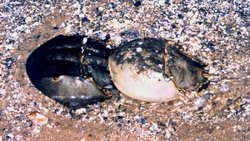Horseshoe Crabs
|
|
| Horseshoe crab | ||||||||||||||
|---|---|---|---|---|---|---|---|---|---|---|---|---|---|---|
 Pair of horseshoe crabs | ||||||||||||||
| Scientific classification | ||||||||||||||
| ||||||||||||||
| Binomial name | ||||||||||||||
| Limulus polyphemus Linnaeus, 1758 |
The horseshoe crab (Limulus polyphemus), also known as king crab, is an arthropod that is more closely related to spiders than crabs. They are most commonly found in the Gulf of Mexico and along the northern Atlantic coast. A Japanese variant (Tachypleus tridentatus) is found in the Seto Inland Sea, but is considered an endangered species through loss of habitat. They can grow up to 20 inches (51 cm), on a diet of mollusks, worms, and other invertebrates. They find this prey under the sand, where they spend most of their lives. In captivity, its diet should be supplemented with meaty items such as pieces of squid and shrimp (Foster and Smith, 2004). Its mouth is located in the middle of the underside of the cephalothorax. A pair of pincers (chelicerae) for seizing food are found on each side of the mouth.
Horseshoe crabs possess five pairs of book lungs (sometimes known as book gills) located just behind their appendages that allow them to breathe underwater, and can also allow them to breathe on land for short periods of time, provided the lungs remain moist. The outer shell of these animals consists of three parts. The carapace is the smooth frontmost part of the crab; it has on it the eyes, the walking legs, the chelicera (pincers), the mouth, the brain, and the heart. The abdomen is the middle portion where the gills are attached as well as the genital operculum. The last section is the telson which is used to flip itself over if stuck upside down.
Limulus has been extensively used in research into the physiology of vision. It has four compound eyes, and each ommatidium feeds into a single nerve fibre. Furthermore the nerves are large and relatively accessible. This made it possible for electrophysiologists to record the nervous response to light stimulation easily, and to observe visual phenomena like lateral inhibition working at the cellular level. More recently, behavioural experiments have investigated the functions of visual perception in Limulus. Habituation and classical conditioning to light stimuli have been demonstrated, as has the use of brightness and shape information by male Limuli when recognising potential mates.
Since 1964 a substance in their blood called "Limulus amebocyte lysate" (LAL) has also been used to test for bacterial endotoxins in pharmaceuticals and for several bacterial diseases. The animals can be returned to water after extraction of a portion of their blood (except in Massachusetts, where their return is prohibited), so this is not necessarily a threat to the survival of horseshoe crabs. Horseshoe crabs have blue blood.
Horseshoe_crab_female.jpg
Horseshoe crabs can live for sixteen to nineteen years. They migrate into the shore in late spring, with the male arriving first. The female then arrives and makes a nest at a depth of 15-20 cm in the sand. In the nest, females deposit eggs which are subsequently fertilized by the male. Studies conducted in Delaware have revealed an average of 3,650 eggs laid per nest. "Development begins when the first egg cover split and new membrane, secreted by the embryo, forms a transparent spherical capsule" (Sturtevant). The larvae form and these larvae swim for about five to seven days. After swimming they settle, and begin the first molt: this happens approximately twenty days after the formation of the egg capsule. As young horseshoe crabs grow, they move to deeper waters. During this time, molting still takes place for two to three years. They reach sexual maturity in five to seven years. The main cause of death during these days is the fish bait industry, which collects horseshoe crabs to make bait for lobsters and other catches.
Although most arthropods have mandibles, the horseshoe crab is jawless. The horseshoe crab's mouth is located in the center of the body.
Horsehoe crabs are distant relatives of spiders and are probably descended from the ancient eurypterids (sea scorpions). They evolved in the shallow seas of the Paleozoic Era (540-248 million years ago) with other primitive arthropods like the trilobites. Horseshoe crabs are one of the oldest classes of marine arthropods, and are often referred to as "living fossils", as they have not changed much in the last 350 to 400 million years.
No living species of horseshoe crab is endangered yet, but harvesting and habitat destruction have reduced their numbers at some locations and caused some concern for these animals' future.
Conservation
Since the 1970s, the horseshoe crab population has been decreasing, owing to several factors, including the use of the crab as bait in conch trapping.
In 1995, the nonprofit Ecological Research and Development Group (ERDG) was founded with the aim of preserving the four remaining species of horseshoe crab. Since its inception, the ERDG has made significant contributions to horseshoe crab conservation. ERDG founder Glenn Gauvry designed a mesh bag for conch traps, to prevent other species from taking off with the bait. This has led to the amount of bait needed being decreased by approximately 50%. In the state of Virginia, these mesh bags are now mandatory in conch fishery.
Every year, around 10% of the horseshoe crab's breeding population dies when rough surf flips the creatures onto their backs, a position from which they often cannot right themselves. In response, the ERDG launched a "Just Flip 'Em" campaign, in the hopes that beachgoers will simply turn the crabs back over.
